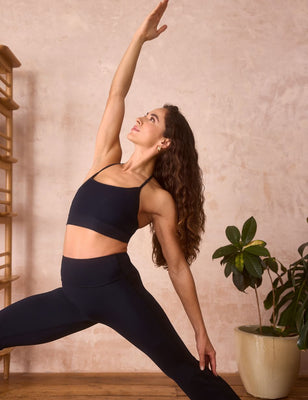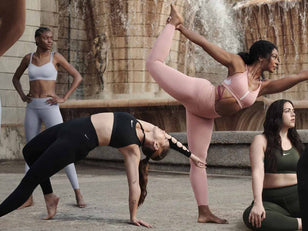
The Wellness Industry is globally worth approximately $4.5 trillion. Yoga contributes to around $84billion into this space and is a huge component of this industry. Chances are, when you think of yoga; compassion, acceptance, inclusivity and honour are some of the words that you would associate it with. Unfortunately, this isn’t what I’ve come to know of the industry as a yoga teacher born in England, with Indian origin.
In the western world, yoga is mainly associated with middle class, white, thin, able-bodied women. If you type yoga into Instagram, you’ll see awe-inspiring photos of men and women in postures that some may find impossible to attain. Since becoming a yoga teacher nearly 5 years ago, it plays on my mind that there have been many situations in Wellness spaces where I’ve felt intimidated and unwelcome, and that’s with me being confident in my yoga practice and as a teacher. I can only imagine how newer teachers must feel.
YOGA’S ROOTS AND ORIGIN
Yoga’s roots lie in ancient India, the word Yoga, which has become so popular in our vernacular, is a Sanskrit word that first appeared in the Vedas; these are sacred ancient texts of Hinduism. The word Yoga itself means ‘to yoke’, which means to create union. This ‘union’ is essentially a union with the universe: our lower egos with our higher selves; a union of breath and body; of mind, body and soul.
To gain a deeper understanding of the history of Yoga, The Bhagvad Gita (basically the Hindu Bible) is there to help. This sacred ancient scripture is an epic poem that takes place on a battlefield which is believed to be a metaphor for a battlefield of the mind. It focuses entirely on yoga, but you won’t find handstands or downward dogs in these scriptures. This practice was entirely spiritual. Yoga consists of 8 limbs, the physical practice which you see in studios is just one of those 8 components.
HOW YOGA’S ROOTS MANIFEST IN PRACTICES TODAY
Today in the western world, yoga has become incredibly mainstream and is often viewed through the lens of the physical practice; asana. However, the benefits of yoga reach far deeper than that. Yoga has a distinct focus on breathwork (pranayama) and inner workings of the mind.
Regardless of what studio you choose to practice in, it is more likely than not that your teacher will include some sort of meditation during the beginning or ending of a class, cultivating calm. In its essence it is incredibly difficult to separate yoga from its roots, and quite frankly, I don’t see why you would want to.

BLM AND PROMISES TO DO BETTER
Back in May of last year, when Black Lives Matter Protests took place around the world, the Wellness Industry joined in, we saw the world stand in solidarity with the hashtag #blacklivesmatter and promises to review and revise their practices to ensure inclusion for ‘people of colour’.
The fact that we haven’t been considered to be included before this time is beggar’s belief. In London, we saw yoga studios and wellness spaces post black squares to their Instagram alongside pledges to do, and more importantly be better. These establishments seemed to be taking positive steps to change their predominantly white-washed image and genuinely make a change. As an Indian yoga teacher, I was quietly hopeful that this wasn’t just a performative exercise and that these spaces would really do their part to make a change. If they could make diversity and inclusion more than a statement on their website and instead become a fundamental part of their ethos, we have made progress.
If there is an industry that desperately needs to face some harsh realities about its practices and inclusion or lack thereof, it’s the Wellness Industry – and Yoga in particular. Having left the world of finance (which is by no means perfect) however there are also spaces where prayer rooms are kept to accommodate employees’ religious beliefs, and cultural events are held, I was blindsided when I became a yoga teacher.

MY EXPERIENCE AS A POC YOGA TEACHER
Overnight the colour of my skin, my appearance and my social media following became more important to my employability than my knowledge and experience as a teacher. I still struggle to understand that even though yoga comes from India, South Asian teachers are not perceived as the ‘fit’ for some studio’s aesthetic. For such a spiritual practice that helps to relieve stress and anxiety and build mental strength, I, as a teacher, have often been left feeling defeated and insecure in my own skin. This was something which I had never expected.
Merely five months after the world saw numerous posts pledging and promising change, I found myself on the receiving end from a prominent wellness space of not only cultural appropriation but racism too. What initially started out as excitement of finally maybe having an opportunity to represent Indian Teachers in one of these ‘high end’ spaces quickly turned into an experience I am still processing.

I received an email which stated that (paraphrased), “to keep modern city workers feeling ‘inside the circle’ I would not be allowed to use Sanskrit, chant or say Om in their classes”. It was also stated that “they had worked relentlessly hard on their ethos and for this to be their USP”. As an ex-banker I felt insulted that “modern city workers” were deemed so ignorant as to not be able to respect such a practice. That is simply not the case. London is one of the most cosmopolitan cities in the world, compromising more than 270 nationalities and over 300 languages.
Notably the ‘Head of Yoga’ at this studio who emailed me, had never met me. In fact, this was her first correspondence with me. When this was raised to the owners of the studio instead of an apology I was met with an abusive, gas-lit response. After this incident, it came to light that not only was the email from the mentioned ‘Head of Yoga’ absurd, but she herself uses Sanskrit – the very thing she said I could not do for appeasement’s sake. The studio also uses Sanskrit in their social media captions and hashtags, and most infuriating is that this individual profits from Sanskrit when featured in newspaper and magazine articles.
After around 3 weeks, the studio finally relented and publicly stated, “cultural appropriation is real” and promised again to do better. However, to date, I have not received an apology from this Head of Yoga for her actions and their impact. This encounter not only encompasses cultural appropriation, but the racial disregard was evidently clear. It has left me feeling uncomfortable and self-conscious of not only the colour of my skin but also the impact my name can have in regards to the way others deem it acceptable to treat me.
What has left me most uncomfortable by this is that Yoga and its components – which are embedded in my culture – have been used as a weapon against me and my suitability to teach, yet these components have been used by these individuals for profit.
CULTURAL APPROPRIATION VS. CULTURAL APPRECIATION
There is a huge difference between cultural appropriation and cultural appreciation; Appreciation is when people seek to understand and learn about other cultures in order to broaden their knowledge and perspective and connect with others cross-culturally. In this particular incident appreciation did not happen. Appropriation is simply taking one aspect of a culture for personal interest and gain.
As Hindus’ you will not find Hindu God’s in our studio space, or even worse, bathrooms. They are kept in a sacred space where they are worshipped. It would be disrespectful to have an image of a Hindu God on a t-shirt which you wear to a sweaty asana practice. Take a quick glance at mainstream yoga studios, and it becomes clear that some (not all) have unfortunately profited from cultural appropriation.

FINAL THOUGHTS ON HOW YOGA SPACES CAN DO BETTER
Yoga teaches us that through breathing, moving, grounding and coming back to our hearts we are able to let go of ‘labels’ attached to us. A black square on Instagram makes no difference if our core beliefs and ethos still exist. Empty, performative acts of inclusivity are futile at best, and incredibly damaging at worst.
If yoga studios take this opportunity to take time and learn to let go of labels, Instagram followings and cliched stereotypes of what a yoga teacher should look like, this will be the basis to drive the change that so many pledged to achieve.
Action to change is necessary instead of pledges. Taking active steps to tackle this issue of diversity and lack of inclusion affects people of colour. We should be seeing more Indian yoga teachers in studios, not fewer. Indian, South Asian, Asian and Middle Eastern teachers do exist in this space, yet too few are included in the mainstream and on platforms showcasing the popularity of yoga.
It’s ironic that with nearly 10 years working in finance I was never made to feel subservient because of the colour of my skin. On the other hand, experiences in the yoga world have done exactly that. A quote that I read most recently which said, “Change your thought pattern from ‘Why is this happening to me?’ to ‘What is this teaching me?’”. My experiences in this space have taught me that I must elevate my voice, as others may not be able to do so. I am determined to use my voice in an effective way, so that collectively we can drive change in these environments for the better.

































































